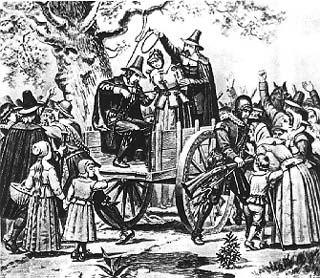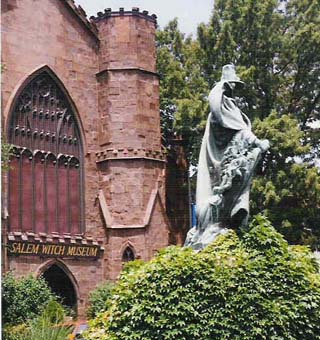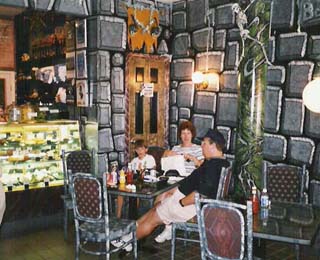|

A
girl is forced to disrobe in a Salem Court so that she can
be checked for marks that would identify her as a witch.
From a painting by Thompkins H. Matteson.
|
Part I:
The Witches of Salem: The Events of 1692
Sometime toward the end of January, 1692, Betty
Parris, nine year-old daughter of the Reverend Samuel Parris,
became ill. She suffered from convulsions that contorted her body.
At times she would cry out and cower under chairs as if frightened
of something. Soon her thirteen-year-old orphaned cousin, Abigail,
who also lived in the Parris household, showed the same symptoms.
Reverend Parris and his wife did not recognize the malady and
had the girls examined by several doctors. The physicians could
find nothing wrong with the girls and by mid-February Dr. William
Griggs declared that he thought "the evil hand is upon them."
After that the word spread quickly through the tiny community
of Salem Village: "There are witches among us."
The events that took place in Salem, Massachusetts,
in 1692 are still shocking and controversial even today. Before
they were over, 19 people would be hung, four would die in jail,
and one would be tortured to death. In its wake the proceedings
would leave shattered families, suspicious neighbors and an embarrassment
to Massachusetts that the state government would still be apologizing
for three hundred years later. While the "why" of what
happened at Salem is still up for debate even today, the "what"
is fairly clear. In 1692 Salem was a small, somewhat poor, village
with a population of around 550 people. It lay just inland from
the much larger port of Salem Town and the residents were mostly
of the Puritan sect. These Protestants had left Europe and settled
in the new world hoping to be able to worship God as they pleased.
Ironically, even though they'd been forced to leave their homes
for religious reasons themselves, the Puritans tended to be very
intolerant of anybody else who broke their strict moral and legal
codes.
A Hard
Life
Life in Salem Village was grim. The winters were
cold and forbidding and good weather brought on the need for hard
work. Like any group of people living closely together, the Puritans
had their "haves" and "have nots" and disputes over land ownership
were frequent. The possibility of an outbreak of the deadly disease
smallpox was a constant concern. Some of the villagers were also
at odds with their spiritual leader, the Reverend Parris, who
was demanding a raise. Attacks by Native Americans had become
common among the towns of Massachusetts in the preceding years,
and this danger also played upon the villagers' minds. Finally,
and perhaps most foreboding of all, this was not the first time
the specter of witchcraft had raised its head in Salem Village.
Four years before a woman named Goody Glover had been accused
of witchcraft and hanged.
Over the following weeks, whatever was happening
to Betty and Abigail seemed to spread to other girls in the community.
To most observers their fits seemed beyond anything the girls
could have created themselves. The Reverend John Hale from a nearby
village wrote, " These children were bitten and pinched by invisible
agents; their arms, necks, and back turned this way and that way,
and returned back again, so as it was impossible for them to do
of themselves, and beyond the power of any epileptick fits, or
natural disease to effect."
Soon the "afflicted" in the village numbered seven,
ranging in age from nine to twenty. Betty, the youngest, was sent
away and spared what was to follow. The others continued to act
strangely and fears that they all were under a witch's evil spell
grew. Finally, one of the afflicted girl's aunt, Mary Stibley,
induced the Parris' family slave, Tituba, to bake a "witch cake"
to reveal the source of the evil. The cake, made of rye and the
girls' urine, was fed to the Parris's family dog, who Stibley
believed to be an evil messenger. The cake and the dog revealed
nothing, however, and earned Stibley a public rebuke from Rev.
Parris, who thought that using "white magic" to combat "black
magic" was unwise as he found all magic to be the tools of the
devil.
The
Accusations Begin
|

A
woman is hanged for witchcraft in Salem.
|
As the end of February approached, pressured mounted
on the girls to reveal the name of the witch or witches that tormented
them or somehow explain their bizarre behavior. Finally, seventeen-year-old
Elizabeth Hubbard named the Parris' slave, Tituba, as the witch.
Not much is known about Tituba other than she grew
up on the island of Barbados. She was likely of Native American
background, but nobody knows for sure. What is known is that during
the preceding winter months she kept some of the girls entertained
with stories of her native land with its strange traditions, games
and magic. In quick succession two other women were also named
as witches by the girls: Sarah Good and Sarah Osborn. The girls
claimed that the women "or specters in their shapes did grievously
torment them." Both the women were unpopular within the community:
Good smoked a pipe and was bad-tempered. Osborn did not attend
church and was entangled in a land dispute over her first husband's
will.
To be accused of witchcraft in those days was no
minor matter. In 1641 the English law had made the practice a
capital crime. It was thought that witches, who could be either
male or female, had made a pact with Satan agreeing to serve him
in return for certain powers which included the ability to curse
other people. Tituba, Good and Osborn were arrested on February
29th. The next day after questioning, which surely included a
beating, Tituba confessed "the devil came to me and bid me to
serve him." She also confirmed that Good and Osborn were her sister
witches. Her confession also made mention of a mysterious man
in black (perhaps the devil) and tales of flying through the air
on a broomstick.
Other accusations followed: Rebecca Nurse, Martha
Cory, Sarah Cloyce, and Elizabeth Proctor were arrested in March
and April. On April 11, John Proctor, husband of Elizabeth, became
the first man arrested for witchcraft after he protested the arrest
of his wife. Mary Warren, a maidservant of the Proctors and one
of the "afflicted" girls, recanted her accusations after her employers
were jailed saying that she and the other girls were lying. The
other girls immediately turned against Mary and accused her of
witchcraft. She quickly changed sides again saying that she was
lying about lying.
On May 27th the newly-elected governor, William
Phipps, commissioned the Court of Oyer and Terminer to try these
cases. The "afflicted girls" were star witnesses for the prosecution.
The court also allowed the use of "spectral evidence" which meant
that the girls could testify to seeing invisible entities that
nobody else could. The result of this was that no matter how wild
a story the girls made up, even though there was no way to corroborate
it with independent witnesses or evidence, it was still believed.
This would even play itself out in the middle of the courtroom.
If a defendant looked like that might win an acquittal, the girls
might suddenly start screaming and contorting their bodies as
if in pain. The girls would claim that the ghost, or "specter,"
of the defendant, which only the they could see, was attacking
them.
The
"Witches" are Put to Death
On June 2, 1692, Bridget Bishop became the first
person to be tried and convicted of witchcraft. Eight days later
she was hung on Gallows Hill. By July 19 there was a second round
of trials and convictions and five more women thought to be witches
were hung. More trials followed. August 19 saw five more hanged,
mostly men. John Proctor was among the group. His wife Elizabeth
only escaped the noose because she was pregnant.
|

A
statue of a Puritan stands in front of the Witch Museum
in modern Salem town.
|
Before the trials were over, 141 people were arrested
for witchcraft. Ironically, only the honest people died. If one
was willing to confess to witchcraft they were forgiven. In fact,
not one person who actually confessed to witchcraft was hanged
or even brought to trial . This forgiveness came with a price,
however, as the accused were pressed to name other witches in
the community. While some people did this reluctantly, others
probably found it an excellent opportunity to settle old scores.
Sometimes this backfired, however. Giles Cory, who
earlier had refused to defend his wife when she was accused of
witchcraft, found himself under arrest as family members of witches
were looked at with considerable suspicion. Through a quirk of
law, a person could not be tried unless they submitted a plea
to the court. Giles Cory refused to do this, and to make him cooperate
sheriff's officers administered the Peine Forte Et Dure
to him. This torture consisted of putting the person under a large
wooden board and piling rocks on top of them until they said what
you wanted them to say. Giles Clory did not cooperate, however,
and after two days of being crushed, died.
The "afflicted girls," who for the most part were
servants, orphans and the weakest members of their society, suddenly
realized they had great power. They could strike fear into the
hearts of even the most powerful families in the village. Their
names were on everybody's lips as far away as Boston and they
were invited to other towns in the area to help expose witches.
More and more people were arrested and the hysteria spread through
Massachusetts.
An
End to the Madness
It is hard to say how long this would have continued
if the Governor's own wife had not been accused of witchcraft.
This prompted him to take control of the situation. On October
8th he ordered that spectral evidence no longer be allowed at
trials. At the end of the month he prohibited any more arrests,
released many of those in jail, and dissolved the court. Though
the hangings were over at that point, it still took until May
of 1693 before all those charged with witchcraft were either released
or pardoned.
What happened at Salem lay as an open wound in the
Massachusetts colony for many years. In 1697 the General Court
ordered a day of fasting and soul-searching for what had happened
at Salem. Samuel Sewall, who was one of the judges, publicly confessed
to his error and guilt in the fraudulent convictions. Nine years
later Ann Putnam Jr., one of the "afflicted girls," publicly apologized
for her part in the tragedy. The village of Salem, prompted by
the shadow of the trials, renamed itself to Danvers in 1752. Finally,
in 1957, the State of Massachusetts formally apologized for the
events of 1692.
|

Visitors
can grab a bite to eat the the creepy Crypt Cafe.
|
Today the town of Salem revels in its connection
to the rather sordid history of the nearby village. Visitors can
go and visit a memorial dedicated to those that died or learn
about what happened from museums, historical plays or tours. They
can even have lunch at the Crypt Café which has an appropriately
creepy atmosphere.
The question that still haunts us today, however,
is why did it happen? What caused the girls to behave strangely
and accuse their neighbors? Almost none seriously believes that
witches were responsible. If Satan was not the source of this
tragedy, what was?
Part II: The Witches
of Salem: Theories and Speculations

Copyright
Lee Krystek 2006. All Rights Reserved.